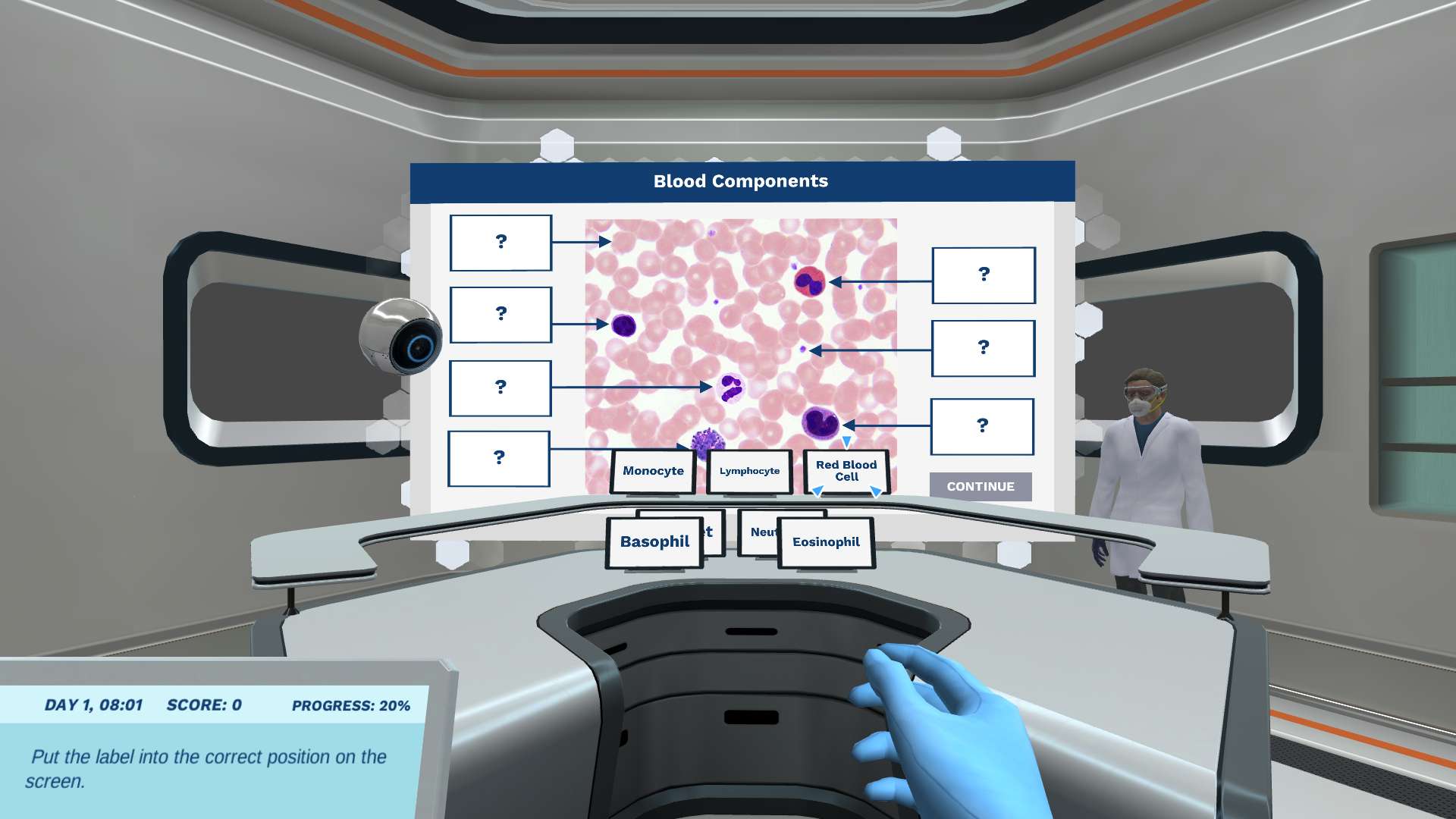Heading 1
Heading 2
Heading 3
Heading 4
Heading 5
Heading 6
Lorem ipsum dolor sit amet, consectetur adipiscing elit, sed do eiusmod tempor incididunt ut labore et dolore magna aliqua. Ut enim ad minim veniam, quis nostrud exercitation ullamco laboris nisi ut aliquip ex ea commodo consequat. Duis aute irure dolor in reprehenderit in voluptate velit esse cillum dolore eu fugiat nulla pariatur.
Block quote
Ordered list
- Item 1
- Item 2
- Item 3
Unordered list
- Item A
- Item B
- Item C
Bold text
Emphasis
Superscript
Subscript
About This Simulation
Learn how to identify the key, physical characteristics of the blood components and understand their functions. Apply your knowledge to analyze patient’s blood samples and suggest possible diagnoses.
Learning Objectives
- Identify the key components of blood and their primary roles
- Recognize the key characteristics of each cell type
- Understand the primary functions of the blood cells
About This Simulation
Lab Techniques
Related Standards
- EHEA Second Cycle
- EHEA First Cycle
- SCQF 10
- SCQF 9
- Early Stage Bachelors Level
- US College Year 1
- US College Year 2
Learn More About This Simulation
In this simulation, you will learn the fascinating science of blood analysis by identifying and examining different types of blood cells. You'll get hands-on experience in Labster’s Blood Analysis Lab, creating blood smears, using a microscope for in-depth analysis, and even diagnosing blood cell disorders. One of the unique selling points of this simulation is the opportunity to make mistakes and learn from them in a risk-free and supportive environment.
Meet the blood components
This immersive experience is designed to transform you into a pro at blood analysis, with a comprehensive understanding of the key characteristics and vital roles of red blood cells, white blood cells, and platelets.
Your Mission: Blood Analysis
Today in the lab we’ll meet Vlad, who wants to be a blood donor but needs your help. We also have blood samples from several other patients that need your expert skills to analyze. To do this, you'll learn to prepare blood smears—a foundational technique in hematology. Then, you'll use a microscope to analyze the blood smears we created in the lab applying your knowledge of blood components’ size, shape, and staining characteristics.
Diagnose and report
To complete your mission, you'll confirm Vlad’s eligibility as a blood donor and diagnose disorders like leukemia, sickle cell anemia, and malaria. Your findings will be reported back to the patients and doctors, contributing to patient care.
Are you ready to become a blood cell detective? What diagnoses will you suggest based on your observations? The answers to these questions lie in your hands as you navigate this engaging Labster simulation.
For Science Programs Providing a Learning Advantage
Boost STEM Pass Rates
Boost Learning with Fun
75% of students show high engagement and improved grades with Labster
Discover Simulations That Match Your Syllabus
Easily bolster your learning objectives with relevant, interactive content
Place Students in the Shoes of Real Scientists
Practice a lab procedure or visualize theory through narrative-driven scenarios


FAQs
Find answers to frequently asked questions.
Heading 1
Heading 2
Heading 3
Heading 4
Heading 5
Heading 6
Lorem ipsum dolor sit amet, consectetur adipiscing elit, sed do eiusmod tempor incididunt ut labore et dolore magna aliqua. Ut enim ad minim veniam, quis nostrud exercitation ullamco laboris nisi ut aliquip ex ea commodo consequat. Duis aute irure dolor in reprehenderit in voluptate velit esse cillum dolore eu fugiat nulla pariatur.
Block quote
Ordered list
- Item 1
- Item 2
- Item 3
Unordered list
- Item A
- Item B
- Item C
Bold text
Emphasis
Superscript
Subscript
A Labster virtual lab is an interactive, multimedia assignment that students access right from their computers. Many Labster virtual labs prepare students for success in college by introducing foundational knowledge using multimedia visualizations that make it easier to understand complex concepts. Other Labster virtual labs prepare learners for careers in STEM labs by giving them realistic practice on lab techniques and procedures.
Labster’s virtual lab simulations are created by scientists and designed to maximize engagement and interactivity. Unlike watching a video or reading a textbook, Labster virtual labs are interactive. To make progress, students must think critically and solve a real-world problem. We believe that learning by doing makes STEM stick.
Yes, Labster is compatible with all major LMS (Learning Management Systems) including Blackboard, Canvas, D2L, Moodle, and many others. Students can access Labster like any other assignment. If your institution does not choose an LMS integration, students will log into Labster’s Course Manager once they have an account created. Your institution will decide which is the best access method.
Labster is available for purchase by instructors, faculty, and administrators at education institutions. Purchasing our starter package, Labster Explorer, can be done using a credit card if you are located in the USA, Canada, or Mexico. If you are outside of North America or are choosing a higher plan, please speak with a Labster sales representative. Compare plans.
Labster supports a wide range of STEM courses at the high school, college, and university level across fields in biology, chemistry, physics, and health sciences. You can identify topics for your courses by searching our Content Catalog.















